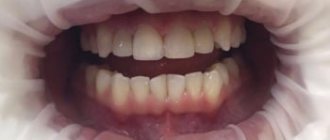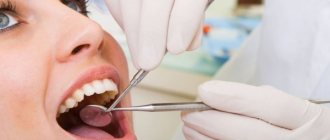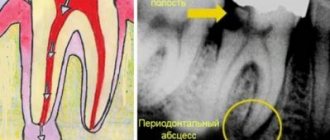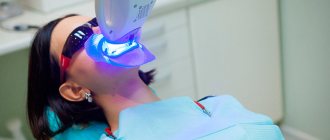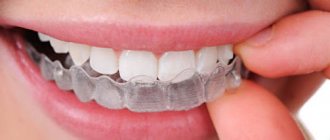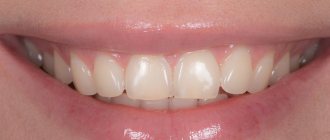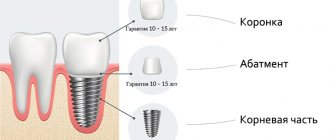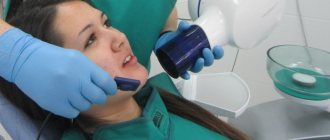If you need to make room before installing orthodontic Invisalign aligners, braces or dentures so that each tooth is in the correct position, separation (interproximal enamel reduction) is performed. The operation is painless, bloodless, minimally traumatic, does not require long-term rehabilitation, but can lead to complications if performed incorrectly on the patient.
What is teeth separation: which doctor does it?
Separation is a technique for expanding the interdental space, during which a thin layer of enamel (no more than 0.25 mm) is removed from the sides of the incisors, thereby freeing up space. Sawing is carried out using a drill, strips, and sometimes a special file is used. Carefully remove the protruding part where the two teeth meet. The procedure is a worthy alternative to extirpation, it allows you to keep your teeth healthy and functional, and
avoids the removal of molars (6, 7 and 8) and other dental units.
Separation of enamel is safe for teeth and does not provoke their hypersensitivity.
Separation in orthodontics
Separation is a procedure for separating teeth by reducing the thickness of the enamel layer.
For a long time, patients had to undergo a tooth extraction procedure before starting orthodontic treatment. This made it possible to free up space in the dentition. Today there is an alternative to this procedure – tooth separation. During separation, the doctor removes part of the enamel from the contact (side) surfaces of the teeth. There is no need to be afraid of this. The enamel becomes thinner by tenths of a millimeter, while its thickness is about 2 mm. At the same time, the procedure allows the patient to preserve his own healthy teeth, which is much more important.
During separation, the doctor grinds down a certain number of teeth. Using diagnostic models and data from other studies, they calculate how much space is needed for the teeth to move freely. As a rule, this is a few millimeters. Teeth separation allows for up to 5 mm of free space for effective orthodontic treatment.
What are the types
There are two ways to carry out separation:
- Mechanical - using a drill with diamond discs, strips or files, a thin layer of enamel (less than 1 mm) is removed from the side surfaces of the incisors.
- Physiological - the interdental spaces expand naturally with the help of wedges, elastic bands, and threads that are inserted into them.
Both methods are practical, but the first method provides instant results. In the second case, you will have to wait several days, so mechanical separation is used more often than physiological separation.
Separation methods
When wearing braces, separation is carried out quite often. It can be prescribed both before the installation of a fixed orthodontic structure, and while wearing it. There are two main types of procedures used in orthodontics today:
- mechanical separation: special dental instruments are used, with which a specialist manually removes a thin enamel layer. After the manipulations, most patients do not experience increased sensitivity of the teeth, but at the same time a little free space appears in the row for the smooth correction of defects,
- physiological: in this case, the doctor resorts to the help of special wedges or threads, which are installed as a kind of spacers. They are placed in the spaces between the teeth, after which the patient walks with them in his mouth for one or several days. Thus, a certain pressure is provided on the teeth, and they move apart naturally.
With the mechanical method, the enamel is ground down with a special tool.
The choice of a specific technique is made by the orthodontist based on the existing clinical picture. In the first case, after grinding, the teeth may react slightly to cold and hot, but this problem quickly goes away on its own.
Advantages
The main advantage of the procedure is the ability to preserve healthy teeth. Additional benefits:
- painlessly and quickly frees up space for orthodontic therapy (correction of crowding or malocclusion, jaw prosthetics);
- no long recovery required;
- soft gum tissue is not damaged;
- there is no need for additional treatment of gums (only in the absence of complications);
- the integrity and sensitivity of the teeth is not impaired;
- The operation is performed in one session lasting up to 40 minutes.
Interproximal enamel reduction is only safe when performed by a qualified, experienced dentist. Therefore, you need to carefully choose a clinic and specialist.
How much money do you need
Not a single decent clinic will calculate the cost of treatment for a patient over the phone. The total cost to a patient depends on many factors:
- scope of diagnostics;
- need for x-rays;
- the scope of the work itself;
- application of anesthesia and other services.
The region of residence of the patient and the qualifications of the doctor are important.
If you decide to take care of your loved one, look for a clinic in your city, choose a doctor who inspires your trust, and start working on improving your appearance. And then - there is no limit to perfection!
Who is indicated for the procedure?
Enamel separation is prescribed in cases where the teeth are healthy and there is no indication for their removal, but the row is too dense, which makes it impossible to carry out orthodontic treatment to correct the bite. Main indications:
- the width of the upper incisors does not correspond to the width of the lower ones;
- protrusion of the upper and lower frontal incisors;
- removal is contraindicated if the bite is misaligned;
- asymmetry or inclination of the teeth of the upper and lower rows;
- correction of triangular teeth, due to the shape of which, after correcting the bite, black small triangles remain between the incisors.
It makes sense to carry out separation before and during wearing orthodontic structures (braces, plates). Mandatory before prosthetics (installation of a crown, bridge), will help with tooth retention (growth retardation). The main goal of the procedure is to correct the shape/size of the tooth and at the same time increase the free space for it to move into the correct position.
Recommendations for aesthetics
The center's hygienist recommends that the patient undergo a month-long course of therapy aimed at remineralizing the enamel. For this, two modern preparations are offered: Tuss Mousse cream or Rocs Medical Minerals gel to choose from. The goal of therapy is to strengthen tooth enamel, even out the color of teeth, and minimize white spots on teeth.
The aesthetic dentist of the center offers a more radical solution that will cope with all problems at once - ceramic veneers. The doctor also drew the patient’s attention to a change in the color of the front right incisor - it is necessary to take an X-ray of the tooth to exclude inflammation in the tooth canals and carry out treatment of the tooth canals and internal tooth whitening. Over time and without proper treatment, the darkening of the tooth may worsen, and the dark tooth will become visible through the veneers.
The patient is currently undergoing remineralization therapy with a hygienist and in the near future plans to continue treatment with an aesthetic dentist to create an ideal smile.
See other examples of bite correction from Dial-Dent specialists here.
Make an appointment for a consultation by phone +7-499-110-18-01 or through the form on the website. You can ask questions about correcting your bite to the chief doctor of the clinic, Sergei Vladimirovich Tsukor, at
Contraindications
Any dental procedures have contraindications. Separation is not carried out when:
- caries;
- pulpitis;
- periodontal inflammation;
- excessive bleeding and sensitivity of the gums.
Also, any infectious diseases of the oral cavity are contraindications to interproximal enamel reduction. Carrying out surgery in the presence of contraindications threatens the spread of infection to healthy teeth and tissues in the oral cavity.
Indications
The advisability of using this procedure, which is gentle on teeth, is determined by the orthodontist, taking into account the general condition of the bone organs and the degree of necessary correction. General indications for separation:
- malocclusion;
- projecting or triangular anterior units;
- too dense dentition;
- crowding;
- erasing the cutting edge;
- installation of veneers;
- installation of bracket systems;
- indications for implantation.
When you need additional space between your teeth, go ahead with the procedure! But first, consult your favorite doctor.
What and how it is performed on the front upper and lower incisors
Mechanical separation on incisors is performed in one visit to the dentist:
- Using a saw and a drill with a diamond disc (special tip), the side sections of the enamel are removed in an even layer. To prevent injury, the mirror pushes back soft tissue. The file is used less frequently than the vertical attachment of drills, but provides higher accuracy.
- Sawed surfaces are ground and polished. Sanding smoothes out unevenness.
- To protect teeth from hyperesthesia, a strengthening composition is applied to the enamel.
Immediately after the operation, you can see the result - an increase in the space between the incisors. Physiological separation differs in many ways from mechanical separation and takes longer:
- Wedges are inserted into the interdental spaces or they are stretched with rubber bands.
- The patient is sent home for a certain time.
- The wedges are removed and further therapeutic manipulations are carried out.
After the procedure, if it is necessary to correct the bite, an elastic chain is placed on the dentition to close the gaps. They are tightened due to the alignment of the bite over one to four months.
Results of orthodontic treatment
Thanks to modern diagnostic and treatment methods, it has become possible to eliminate protrusion and straighten teeth without removing teeth. The facial profile has become more harmonious.
| Profile before treatment | Profile after treatment |
The duration of treatment was 14 months, the cost was 170,800 rubles.
Consolidation of treatment results
Despite the fact that after moving teeth, bone tissue forms around them again, most often this is not enough to keep the teeth in their “new place.” Therefore, after treatment with braces or aligners, you still have to wear mouth guards (usually only at night), and install a retainer on the inside of your front teeth (you may have to “endure” it all your life).
retention guard
thin metal arch – non-removable retainer
We figured out what is common between treatment with braces and aligners. Now it's time to talk about each of these systems. Let's start with braces.
Progress of the operation
When mechanically processing the dentition, files or special discs are used to remove a thin layer of enamel. Before starting the procedure, local freezing is often introduced. Discs are more often used to treat teeth, as they remove enamel quite effectively.
During the operation, the doctor uses a mouth mirror to push back the soft tissue. This allows you to prevent the development of the inflammatory process that occurs as a result of mechanical damage to the latter.
At the end of the operation, the treatment area is further polished. Particular attention is paid to sharp edges. They can cause serious damage to the soft tissues of the oral cavity and provoke the development of dental pathologies. To avoid increased sensitivity, the treated teeth are additionally coated with a special compound.
What does an orthodontist treat?
Such a direction as orthodontics in the field of modern dentistry appeared not so long ago.
During physiological separation, wedges are inserted between problematic molars. They are embedded in the natural gaps between the teeth and create free space within 24 hours. The duration of wearing such wedges is determined based on individual indications.
If separation was carried out for the purpose of further installation of braces, then at the end of the procedure the doctor removes plaque and stone from the surface of the teeth and polishes the enamel. Next, a selected system is fixed on the jaw row, which must be worn for several months.
Correcting a bite with aligners
Compared to braces, aligners are clearly perceived as a super-modern, innovative technology for correcting bites, but this method was invented more than 50 years ago.
If you are interested in the history of the appearance of aligners, watch the video blog of the founder of the Russian company Star-Smile (one of the manufacturers of aligners).
Initially, treatment planning and aligner manufacturing technology were too labor-intensive, making the method expensive. At the same time, the aligners coped only with very simple defects.
A real breakthrough in the production of aligners occurred in 1997, when the American company Align Technology came up with a technology that made it possible to simulate a treatment plan for a specific patient on a computer and then automatically print a customized set of aligners to correct the bite. And all this on the scale of a large enterprise.
For more than 10 years, the company was the world's only supplier of aligners, and Invisalign orthodontic aligners still remain the most famous. The monopoly on production was protected by patents owned by the company, but as their validity expired, the technology for producing aligners spread throughout the world, including coming to Russia.
Active competition from manufacturers has made aligners more accessible and today they are cheaper than individual lingual braces, which we described above.
Possible complications
Errors made by a doctor during the process of teeth separation lead to:
- damage to the pulp, which can cause tissue death;
- increasing the sensitivity of treated teeth;
- inflammation of the gum tissue.
These consequences arise only due to the low qualifications of the attending physician. Moreover, the patient himself is able to identify shortcomings in the work of a specialist. To do this, you need to pay attention to how the doctor holds the tip of the drill machine: his hand should be fixed on the patient’s chin.
Why restore your bite?
A direct connection has been established between the condition of the oral cavity and the functioning of the gastrointestinal tract. Due to malocclusion, a person does not chew food enough. And large pieces of food penetrate into the gastrointestinal tract, provoking the development of various pathologies.
Why can our articles be trusted?
We make health information clear, accessible and relevant.
- All articles are checked by practicing doctors.
- We take scientific literature and the latest research as a basis.
- We publish detailed articles that answer all questions.
In addition, malocclusion often causes the development of dental diseases. For example, due to a violation of the structure of the dentition, the mucous membrane is often subjected to mechanical stress. Microcracks regularly form on its surface, through which pathogenic microflora penetrate. The active development of bacteria leads to the appearance of foci of inflammation.
In advanced cases, malocclusion becomes the cause of the development of sinusitis, which, when complicated, provokes the appearance of meningitis and other equally dangerous pathologies. Some of these diseases lead to death.
Bite restoration is a necessary procedure to prevent the development of many diseases.
Pros and cons of separation
The enamel recontouring method has many strengths. There are also disadvantages, but they are usually a consequence of the doctor’s incompetence. Let's list them first.
Minuses:
- damage to enamel, increased sensitivity - occurs if you ignore the patient’s initial data or start work without an x-ray;
- pulp damage - due to the low level of professionalism of the doctor;
- local inflammation of the gums is a mild side effect, quickly relieved by rinsing or special gels.
Pros:
- there is no need to remove healthy teeth - the most compelling reason why you should agree to the procedure;
- there is no recovery period - everything is ready for further work, no need to wait for adaptation or healing;
- practically painless - in rare cases, the patient may experience only mild discomfort;
- The process is quick and can be completed in one visit.
After treatment, teeth will not become more susceptible to plaque, caries, or abrasion. With good hygiene and the absence of bad habits, turning will not affect your health in any way.
Separation prices
The cost of the service, of course, depends on the chosen method. But if we are talking about the grinding or stripping method, then the price is announced for one processed unit. Usually it fluctuates around 500 rubles. Depending on the region, the cost may increase or, conversely, be less.
If you are still intimidated by the prospect of machining, read the reviews of those who have already completed this stage. People successfully completed treatment without unnecessary removal. Based on this, it can be understood that the technology of enamel recontouring is truly a gentle procedure with minimal impact and enormous therapeutic potential.
Forecast
When going to the dentist’s office, the patient hopes for comfortable and high-quality treatment, the doctor’s understanding and the desire to make every effort to restore and preserve the client’s teeth.
Separation is not yet a widely accepted tooth-preserving method for correcting defects of the maxillofacial region. However, when there is a shortage of space for adjacent units, this is the most effective way to obtain it.
For information on the separation of interdental spaces, watch the video.
Start treatment with a consultation with an orthodontist
By reading this article, you were probably able to see that it is not the equipment that cures, but the doctor, so if you are thinking about correcting your bite, start with a consultation with an orthodontist.
After an examination and examination, which includes taking impressions of both jaws to make diagnostic models, computed tomography and telex-rays, you can discuss various treatment options with your doctor and choose the most suitable one.
You can make an appointment with orthodontist Marina Nikolaevna Khomyakova right now.
